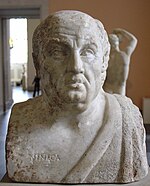Pseudo-Seneca

The Pseudo-Seneca is a Roman bronze bust of the late 1st century BC that was discovered in the
"Pseudo-Seneca" is also used for the uncertain authors of various antique and medieval texts such as De remediis fortuitorum, which purport to be by the Roman author.[1] At least some of these seem to preserve and adapt genuine Senecan content, for example Saint Martin of Braga's (d. c. 580) Formula vitae honestae, or De differentiis quatuor virtutumvitae honestae ("Rules for an Honest Life", or "On the Four Cardinal Virtues"). Early Mss. preserve Martin's preface, where he makes it clear that this was his adaptation, but in later copies this was omitted, and the work became thought fully Seneca's work.[2]
History
The type of this bust was first given its identification as a "genuine" contemporary portrait of Seneca by
Following the example of
Of the Herculanean version of the Pseudo-Seneca, as it is still widely known, the outstanding quality was quickly recognized by
In 1813 a Roman image of Seneca was found on an inscribed marble herm portrait, which showed a man with quite different features.

Erika Simon believed that it represented Hesiod and that the lost original was created in the circle of
Nowadays the prevailing interpretation is that the head is a portrait of a dramatist due to the presence, on a copy now at the
Museo delle Terme at Rome, of an ivy wreath, the prize for theatrical contexts: some scholars specifically identify him as Aristophanes, because the type in question is associated, in a double herm of Villa Albani, with the portrait of Menander; according to other experts, it could be a portrait of Aesop, Hesiod, Callimachus or Apollonius of Rhodes. We can therefore be quite certain that the person depicted must have been extremely famous, as is proven by the large number of copies to survive, which number a total of forty. From the qualitative point of view, the head displays excellent workmanship; rather than a copy, it might well even be the original from which all the others are reproduced, and should be regarded as a portrait of reconstruction in which the accentuated wrinkles and folds of the face and forehead of the man, the intentionally unruly locks and the wrinkly neck contrast openly with the unwavering, penetrating gaze. The original should be ascribed to the trend of realistic virtuosity, dateable to between the third and second century BC.
References
- ^ "A large corpus of apocrypha - viz. falsifications, false attributions and extracts - compiled during Late Antiquity and the Middle Ages has been connected to Seneca..."
- ^ The Cardinal Virtues in the Middle Ages: A Study in Moral Thought from the Fourth to the Fourteenth Century, pp. 55-57, Brill, 2011
- ^ Printed in Rome, 1570. Gallaeus' title was Illustrium Imagines ex Antiquis Marmoribus Nomismatib[us] et Gemmis Expressae... (Antwerp 1598). Noted by Francis Haskell and Nicholas Penny, Taste and the Antique: the Lure of Classical Sculpture 1500-1900 (1981), p 52 and note 67.
- ^ Haskell and Penny, Taste and the Antique: the Lure of Classical Sculpture 1500-1900 (1981), p 52.
- ^ Silvae 2.2, discussed by Claudia J. Hough, "The Surrentine Villa of Pollius Felix" (on-line text).
- ^ Fulvio Orsini's Imagines et elogia virorum illustrium (Rome, 1569), Paolo Giovio's "Giovio Series", Jean-Jacques Boissard's Icones Virorum Illustrium (1597) and Antonio Francesco Gori's Imagines virorum illustrium et deorum (1731-32) are familiar exemplars of the perennial cultural theme.
- ^ Haskell and Penny 1981:52.
- ^ M. Vickers, "Rubens' 'Seneca'?" The Burlington Magazoine119 (1977).
- ^ Geschichte der Kunst des Alterthums, 1764 in Winckelmann's Werke, Bk. 10, chap 3, 201f, §4.
- Staatliche Museen, Berlin.
- JSTOR 3047713.
- ^ Gisela Richter (1965). The Portraits of the Greeks. London: Phaidon. pp. I, 58ff.
- ^ Commentators agreeing with Richter:
- Prinz, Wolfram 1973. "The Four Philosophers by Rubens and the Pseudo-Seneca in Seventeenth-Century Painting" The Art Bulletin 55.3 (September 1973), pp. 410-428. "...one feels that it may just as well have been the Greek writer Hesiod..."
- Robertson, Martin Review of G, Richter, The Portraits of the Greeks The Burlington Magazine 108.756 (March 1966), pp 148-150. "...with Miss Richter, I accept the identification as Hesiod"
- ^ Erika Simon (1975). Pergamon und Hesiod. Mainz am Rhein: Philipp von Zabern.
- ^ Museo Archeologico Nazionale: Portrait head of so-called Seneca Archived 2012-03-12 at the Wayback Machine
External links
![]() Media related to Pseudo-Seneca at Wikimedia Commons
Media related to Pseudo-Seneca at Wikimedia Commons

